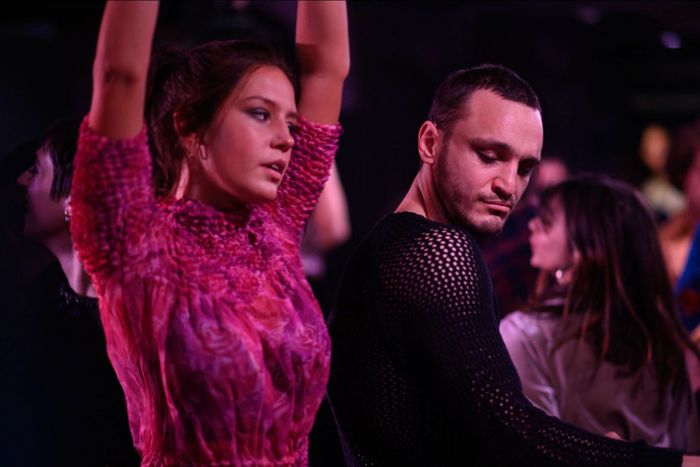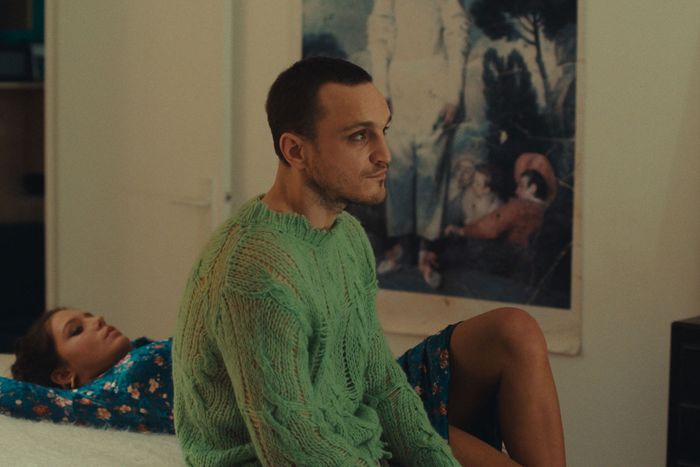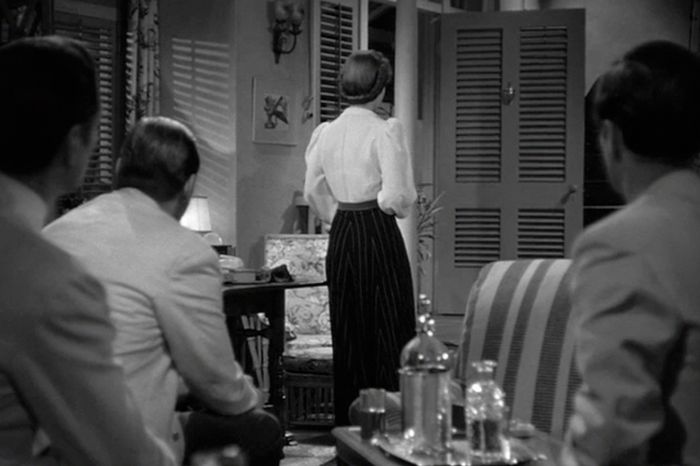
This article was featured in One Great Story, New York’s reading recommendation newsletter. Sign up here to get it nightly.
Passages is a movie that unfurls with each scene like a petal peeling back to reveal little despairs and grand desires — the brilliant hues of an adulthood well lived. It isn’t glossy or hermetically sealed. It is open. It is wanting. It is alive. This is evident from the jump.
Second scene. It’s an after-party at a thumping Parisian nightclub, celebrating the end of a film shoot for the German director Tomas (Franz Rogowski). Bodies slink in and out of the shadows. Electronic grooves pop across the soundscape. The air seems thick with conflict and hunger, encompassing Martin (a delicate, dynamic Ben Whishaw) and Agathe (Adèle Exarchopoulos, enrapturing as ever), who is cool until Martin’s husband, Tomas, appears. “It’s my party and my husband doesn’t want to dance with me,” Tomas says. Agathe offers to dance in Martin’s stead. So they dance. Tomas in his tight midnight-black sweater, skin peeking through the knitting. Agathe in a textured top of ripe magenta. Around and toward each other, they saunter, smile, flirt, groove. It’s in wordless gestures that the arrival of a torrid affair makes itself known.
In this scene, the camera’s rapturous gaze is fixed on Tomas’s back, as if it’s obsessed with the stories the body can uniquely tell. As he rolls his shoulders, a downright lycanthropic grin cuts across his face. With every flick of movement, the skin peeking out from underneath the black of his sweater glimmers in the dusky light of the dance floor. When Martin leaves abruptly, the warm machinations that play across Tomas’s face seem to sharpen Rogowski’s features. But it is on his back that desire is written, and for a moment the emotion that gives the film its pulse is housed in a singular space.
It’s the same back we see returning to the home he shares in Paris with his husband the next morning. He hesitates before unlocking the door, still in that black sweater, skin still rippling underneath, practically buzzing with illicit energy. He makes it to their bedroom, his back again to the camera, only a sliver of his face exposed. In his back, there is tension and trepidation. Such hesitancy is unlike Tomas, a man so primed on having his exigencies fulfilled that he believes the only cost will be his time and effort. “I’m sorry. I should have called,” he shouts to Martin in the kitchen. As he joins his husband, the camera finds Martin’s face over Tomas’s shoulder, his muscles softening. “I had sex with a woman,” Tomas confesses, his cautiousness giving way to relish. “Can I tell you about it, please?” In the brevity of this scene, the entirety of their dynamic is sketched out: Tomas’s refusal to deny pleasure or apologize to whom such a pursuit hurts. His selfishness. His incandescent quality that complicates the cruelty. Martin’s kindness that doubles as a longing for respect that is never met. The harshness of Tomas, the tenderness of Martin.
In scene after scene, the back (Tomas’s, most acutely) is the architecture for Passages’ psychological interests — its deliberations on connectivity, rejection, and lust. When Tomas fucks Agathe again near his editing room, his back is the focal point. This is a fuck about pleasure, but it’s also an escape from something and into something else entirely. They’re sloppy, loud. The muscles in Rogowski’s back flex with force. Every thrust is a physical representation of his hungry desperation. They’re clumsy, too, as he stumble-carries Agathe from one part of the room to another, ramping up and then slowing down until they’re at a simmer. Rogowski wears desire like a fine leather trench coat. No, that’s not quite right. It isn’t something he puts on, then casts off. It’s a part of him, an extension of his being. A second skin so tight it doesn’t feel second to anything at all. There is no such thing as sated for a man like this.
The face of an actor is usually the greatest visual terrain in film. But in modern cinematic parlance, close-ups are over–relied upon, leading directors to lose out on the full portrait of a character that can be revealed when a body speaks as much as our mouths. Director and co-writer Ira Sachs’s camera masterfully maps the entire physical space of Rogowski, though the real power of back-acting onscreen — in Passages and elsewhere — comes from the choices an actor makes, not the cinematographic decisions guiding the film. When Alfred Hitchcock introduces the audience to Cary Grant as the slippery Devlin in 1946’s Notorious, we witness the very upper back of his body, an eerie cool to his presence and his shellacked tar-black hair. The power in this moment is in Hitchcock’s and cinematographer Ted Tetzlaff’s decisions more so than Grant’s. Back-acting happens when an actor makes subtle choices of posture, gait, and bearing to communicate the most firmly held truths of a story and character. Back-acting is Robert Forster at the end of Jackie Brown, the loneliness and regret etched in the way he holds his head high while his body slumps, walking down that hall alone. Back-acting is Kim Min-hee in Park Chan-wook’s The Handmaiden, her back elegant yet withholding as her servant turned lover, played by Kim Tae-ri, undoes the rigid clothing encasing her flesh.
Cinema’s greatest back actor is Golden Age Hollywood’s Medusa, Bette Davis. Her place in the firmament of great actors is indisputable, yet critics tend to focus on her broad qualities. Davis’s ability to communicate fire and fury often gets her misidentified as an actor defined by histrionics. But Davis is a performer who could bring remarkable subtlety to bold, larger-than-life moments. What, in part, makes her an auteur is that she doesn’t need a single line of dialogue to communicate the wealth of a character’s complex interiority. As Sheila O’Malley argues in Film Comment, “You want to know how a character has transformed? Watch Davis walk across a room. You want to understand a character’s objective? Look at Davis’ posture, or how she lights a cigarette, or where she places her hands.”
O’Malley goes on to extol the glory of Davis’s wordless acting moments in the 1940 William Wyler–directed noir The Letter. The first performance of hers that comes to mind when I think of how she excelled at back-acting is the 1941 southern gothic The Little Foxes. It’s the scene in which her character watches her husband, played marvelously by Herbert Marshall, die thanks to her withholding his medication during a heart attack. They’re discussing the contempt that has curdled their marriage. Her back is tight, her steps forceful. But there is a wistfulness to her movements as she walks to the corner of the frame, body turned away from the camera, as if she is considering the girl she once was. The girl that loved this man. It’s easy to focus on her searchlight eyes at this moment, but the ramrod-straight intensity of her posture is crucial. Dance was foundational for Davis. In her first memoir, the former Martha Graham student writes, “I had already learned that the body via dance could send a message. Now I was taught a syntax with which to articulate the subtleties fully. [Graham] would with a single thrust of her weight convey anguish. Then in an anchored lift that made her ten feet tall, she became all joy. One after the other. Hatred, ecstasy, rage, compassion! There was no end once the body was disciplined.” Davis continues, “Every time I climbed a flight of stairs in films — and I spent half my life on them — it was Graham step by step.”
Rogowski was himself a dancer. In discussing this aspect of his life with Mubi’s Notebook, including studying contemporary dance in Berlin and Austria, the actor noted, “I would not really consider myself a dancer in the classical sense, rather a performer that was used to physical theater. I think theater is quite challenging for me. It’s such a huge space, and you have to shout and scream and everything is so intense. I kind of prefer the very intimate space, the fact that the camera can capture very, very tiny spaces and micro-mimics, and you can find a dance in just a way of looking at someone. When you create silence in between your lines, it’s something that in cinema works very differently. Maybe I’m just too shy for theater.” This approach to the body is evident in Rogowski’s work in Passages even when he seems to barely move. Tomas is the kind of man who wants it all, no matter the consequences that follow, so he perpetually carries ravenous energy even in stillness. In his tension-ridden back, we can see the hunger for release and pleasure that sometimes contradicts the sweet, tempestuous mask he wears upon his face.


Whereas Rogowski’s back is endlessly taut, Whishaw’s has a sorrowful elegance crucial to understanding Martin. As his and Tomas’s marriage fractures at breakneck speed, they retreat to their quaint countryside home. Their bedroom is aglow in amber-hued light from the lamps on each side of the low-level bed with Tomas reading How to Write an Autobiographical Novel, by Alexander Chee, under the covers. Martin, in a wisp of a sheer red robe, sits on the bed. His back, his whole being, is still. If Rogowski’s back-acting becomes a vehicle for the film’s consideration of the obliterating, obsessive nature of gratification, Whishaw’s is a study of isolation in a relationship where your basic needs are not only never met but outright ignored. Martin takes off his robe, his boxers, positions himself just so, and hesitates for a long moment, his eyes on his husband, still reading. The suggestion, the hope of sexual connection, dims as the seconds tick by. Martin’s face is clipped by disappointment as he turns off his lamp: “Night night.”
Harsh cut to the slate-blue light of the day beginning to dawn. “Can you really say you’re in love with me?” Tomas asks Martin, the former’s clothed back at the center of the frame now, slumped and unmoving. We can’t see Rogowski’s face or even Whishaw’s through most of this scene — save for a lock of hair, an eye held in intense concentration — so the emotional subtext of their words is gleaned from the actors’ voices and gestures. “Maybe we have to take more risks, not always be so careful,” Tomas suggests, a storm forming faintly somewhere on the horizon. “So now you’re falling in love with someone else, you’re taking that risk?” Martin counters. What adds delectable friction to this scene is not just Tomas’s savagery (he describes Martin as a brother at one point) wrapped up in an egalitarian gloss or Martin’s refusal to quiet his own hurts. It’s in Sachs’s and cinematographer Josée Deshaies’s refusal to hew toward a close-up in a moment when filmmakers and audiences have otherwise been trained to regard an actor’s face as the font of truth.
As Tomas commits deeper to a relationship with Agathe, Martin makes room for a relationship with a fresh Parisian writer, Amad (Erwan Kepoa Falé). Of course, Tomas feels the urge to reassert his primacy in Martin’s life as a result. Under the pretense of wanting to be involved in the potential sale of their countryside home, Tomas shows up to his former abode unannounced in a slutty mesh crop top and cheetah-print jeans. His presence is a dare to Martin. That evening, scantily clothed, Tomas appears at Martin’s cracked bedroom door, a blushing expression on his face. Martin stares at him, taking in the decision that is now a foregone conclusion. Within the span of a breath and an editorial cut, Martin and Tomas are having sex. There’s something ravenous, needy in this fuck. Here is Martin’s long, lonely back as he thrusts into Tomas, the latter’s mouth not full of words like I’m sorry but the moans of undiluted pleasure. Their faces are a footnote in a scene primed to explore the ravel of limbs, the sensuous indentations of spine, shoulder blades, and muscle.
The next morning, Tomas is tangled in the sheets of their bed. He sits upright on the edge of the mattress, one side curled with white sheets, the other with marigold, giving the frame a sense of romanticism. His bare back is the camera’s focal point with only a portion of his profile seen in medium shot. “Agathe is pregnant,” he says unceremoniously to an offscreen Martin. His back rises and falls with each breath, the tension of what could flourish in the light of day giving a small flicker of hope. Can Tomas have it all — Martin, Agathe, and their child? For a moment, it seems he may. They all convene at the countryside home, where Tomas demonstrates utter disregard for Agathe’s emotional life. Alone in bed, she overhears Tomas and Martin in the throes of playful passion. Much later, Agathe reveals to Martin the abortion Tomas has been hiding from him. “Between the two of you, I would disappear,” she says. The final ruptures in these relationships are now unavoidable for Tomas.
“I am miserable in this relationship,” Martin finally proclaims, his back turned to Tomas and the camera as he cooks. “And I don’t want to be in it anymore.” When the camera finally gets to his face, Martin is as unvarnished as ever. Red teary eyes. Pain. Anger. It’s all there. But in his body — the rigidity in his jaw and neck, the nervous patter of his fidgeting hands — is anxiety. An anxiety that speaks to how consuming Tomas can be: “I don’t want to see you again. I’m not interested in you anymore … I want my life back, and I don’t want you in it.” So Tomas rushes to interrupt Agathe’s class in hopes of not being left all alone. But she rejects him: “Look at you. It’s like you’re not even the same person.” Loneliness is now written upon Tomas’s body as he curls on the floor of the school’s hallway, heaving for reprieve. He reveals himself in the curves of his back to be a black hole of need, where neither light nor care can hope to shine through. In the sculpture of his back, one can find truth.






